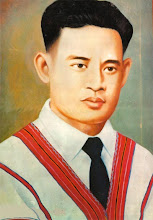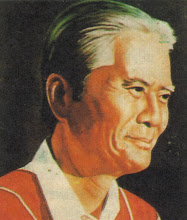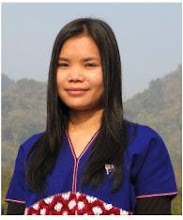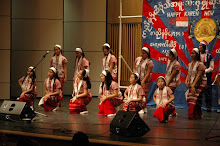We, the Karens of Burma, have been cornered into fighting against the ruling Burmese Governments for the past forty-three years. Holding the reins of all organs of the state, and in full control of the press, radio, and television, the successive ruling Burmese Governments form U Nu’s AFPFL (Anti-fascist People’s Freedom League) to the present Military Junta headed by General Than Shwe and his State Law and Order Restoration Council(SLORC), have always painted us as black as they can. They have branded us insurgents, war mongers, a handful of border smugglers, black-marketeers and stooges of both the communists and the imperialists. Even so, to the extent of our ability we have always tried to refute the nefarious one-sided Burman propaganda of false accusations and make the true facts of our cause known to he world. In fighting against the ruling Burmese Government, we are not being motivated by narrow nationalism, nor by ill-will towards the Burmese Government or the Burman people. Our struggle was instigated neither by the capitalist world nor by the communists, as some have falsely accused us. It has an originality completely of its own. Throughout history, the Burman have been practicing annihilation, absorption and assimilation(3 A’s) against the Karens and they are still doing so today. In short, they are waging a genocidal war against us. Thus we have been forced to fight for our very existence and survival.In this document we venture to present a concise outline of the Karens’ struggle for freedom; the Karen case, which we consider just, righteous and noble. We hope that through it, the world may come to know the true situation of the Karens, a forgotten people who continue to fight for our freedom intensively, single-handendly and without aid of any kind from anyone.
Karen National Union(KNU)
Kawthoolei
I) The Karens, A Nation, Their Nature and History
The Karens are much more than a national minority. We are a nation with a population of 7 million, having all the essential qualities of a nation. We have our own history, our own language, our own culture, our own land of settlement and our own economic system of life. By nature the Karens are simple, quiet, unassuming and peace loving people, who uphold the high moral qualities of honesty, purity, brotherly love, co-operative living and loyalty, and are devout in their religious beliefs. Historically, the Karens descend from the same ancestors as the Mongolian people. The earliest Karens (or Yangs as called by the Thais), settled in Htee-Hset Met Ywa (Land of Flowing Sands), a land bordering the source of the Yang-tse-Kiang river in the Gobi Desert. From there, we migrated southwards and gradually entered the land now known as Burma about 739 B.C.. We were, according to most historians, the first settlers in this new land. The Karens named this land Kaw-Lah, meaning the Green Land. We began to peacefully clear and till our land from all hindrances. Our labors were fruitful and we were very happy with our lot. So we changed the name of the land to Kawthoolei, a pleasant, plentiful and peaceful country. Here we lived characteristically simple, uneventful and peaceful lives, until the advent of the Burman.
II) Pre World War II Eras: Burman Feudalism, British Imperialism and Japanese Fascism
We the Karens could not enjoy our peaceful lives for long. The Mons were the next to enter this area, followed at their heels by the Burman. Both the Mons and Burman brought with them feudalism, which they practised to the full. The Burman later won the feudal war, and they subdued and subjugated all other nationalities in the land. The Karens suffered untold miseries at the hands of their Burman lords. Persecution, torture and killings, spppression, oppression and exploitation were othe order of the day. To mention a few historical facts as evidence, we may refer to the Burman subjugation of the Mons and the Arakanese, and especially their past atrocities against the Thais at Ayudhaya. These events stand as firm evidence of the Burman feudalism, so severe that those victimized peoples continue to harbour a deep -seated resentment of the Burman today.
At the time, many Karens had to flee for their lives to the high mountains and thick jungles, where communications and means of livelihood were extremely difficult and diseases common. We were thus cut off from all progress, civilization and the rest of the world, and were gradually reduced to backward hill tribes. The rest of the Karens were made slaves. We were forced to do hard labour and were cruelly treated.
When the Brithish occupied Burma, the conditions of the Karens gradually improved. With the introduction of law and order by the Colonial Central Authority, the Karens began to earn their living without being hindered, and we could go to school and be educated. This infuriated the Burman, to see the despised Karens being treated equally by the British. Progress of the Karens in almost all fields was fast, and by the beginning of the 20th Century, the Karens were ahead of other peoples in many respects, expecially in education, athletics and music. It could be said that the Karens had a breathing spell during the period of the British Regime. But during the Second World War, in 1942, the Japanese invaded Burma with the help of the Burma Independence Army(BIA), who led them into the country. These BIA troops took full advantage of the situation by insinuating that the Karens were spies and puppets of the British, and therefore were enemies of the Japanese and the Burman. With the help of the Japanese, they began to attack the Karen villages, using a scheme to wipe out the entire Karen populace which closely resembled the genocidal scheme Hitler was enacting against the Jews in Germany. The Karens in many parts of the country were arrested, tortured and killed. Our properties were looted, our womenfolk raped and killed, and our hearths and homes burned. Conditions were so unbearable that in some areas the Karens retaliated fiercely enough to attract the attention of the Japanese Government, which mediated and somewhat controlled the situation.
Post-World War II Eras: Demand for the Karen State, Tensions and Armed Conflicts
The Bitter experiences of the Karens throughout our history in Burma, especially during the second World War , taught us one lesson. They taught us that as a nation, unless we control a state of our own, we will never experience a life of peace and decency, free from persecution and oppression. We will never be allowed to work hard, to grow and prosper.
Soon after the Second World War, all the nations under colonial rule were willed with national aspirations for independence. The Karen sent a Goodwill Mission to England in August 1946, to make the Karen case know to the British Government and the British people, and to ask for a true Karen State. But the reply of the British Labor Government was “to throw our lot with the Burman.” We deeply regretted this, for as it predictably has turned out today, it was a gesture grossly detrimental to our right of self-determination, only condemning us to further oppression. It is extremely difficult for the Karens and the Burmans, two peoples with diametrically opposite views, outlooks, attitudes and mentalities, to yoke together.
However, differences in nature and mentality are not the main reason for our refusal to throw in our lot with the Burman. There are other more important reasons for sticking to our demand for our own State within a genuine Federal Union.
1. We are concerned that the tactics of annihilation, absorption and assimilation, which have be practiced in the past upon all other nationalities by the Burman rulers, will be continued by the Burman of the future as long as they are in power.
2. We are concerned about the postwar independence Aung Sun-Atlee and Nu-Atlee Agreements, as there was no Karen representative in either delegation and no Karen opinion was sought. The most that the Burman would allow us to have was a pseudo Karen State, which falls totally under Burman authority. In that type of Karen State, we must always live in fear of their cruel abuse of that authority over us.
On January 4, 1948, Burma got its independence from the British. The Karens continued to ask for self-determination democratically and peacefully from the Burmese Government The Karen State requested by the Karens was comprised of the Irrawaddy Division, the Tenasserim Division, the Hantha waddy District, Insein District and the Nyauglebin Sub-Division, the areas where the bulk of the Karen populace could be found. But instead of compromising with the Karens by peaceful negotiations concerning the Karen case, the Burmese Government and the Burmese Press said many negative things about us, especially by frequently repeating their accusations that the Karens are puppets of the British and enemies of the Burman. The Burmese Government agitated the Burman people toward communal clashes between the Karens and the Burman. Another accusation against the Karens demand was that it not the entire Karen people who desired a Karen state, but a handful of British lackeys who wanted the ruin of the Union of Burma.
To counter the accusations and show the world that it was the whole Karen people’s desire for a Karen state, a peaceful demonstration by the Karens all over the country was staged on February 11, 1948, in which over 400,000 Karen took part. The banners carried in the procession contained four slogans, namely: 1.Give the Karen State at once 2. Show Burman one Kyat and Karen one Kyat 3. Wedo not want communal strife. 4. We do not want civil war.
The slogans of the Karen in this mass demonstration voiced the same desire as the three slogans of the British Colonies after the Second World War: Liberty, Equality, and Peace. We followed the established democratic procedures in our request for a Karen state.
A few months after Burma got its independence, successive desertions in the AFPFL put U Nu, the then Premier, in grave trouble. The revolts of the Red Flag Communist Party in 1947, the Communist Party of Burma in March 1948, the People’s Volunteer Organization in June 1948, and the mutinies of the 1St... Burma Rifles stationed at Thayetmyo and the 3rd Burma Rifles stationed at Mingladon, Rangoon(August 15, 1948), prompted U Nu to approach the Karen leaders to help the Government by taking up the security of Rangoon, and save it from peril. The Karens did not take advantage of the situation, but readily complied to U Nu’s request and helped him out of his predicament. The KNDO(Karen National Defence Organization), officially recognized by the Burmese Government, was posted at all the strategic positions and all the roads and routes leading to Rangoon. For months the KNDO faithfully took charge of the security of Rangoon.
The KNDO was given several tasks in forming an outer ring of defence, particularly at Hlegu an Twante. Most important of all was the reoccupation of Twante town, Rangoon’s key riverain gateway to the Delta towns an upper Burma. this little town had fallen several times to the communists. Each time it was retaken by regular troops, only to fall back into the hands of the rebels as soon as conditions returned to normal and control was handed back to the civil authorities and the police. This time, a KNDO unit under the leadership of Bo Toe and Bo Aung Min was ordered to retake Twante, which was once more in the hands of the Red Flag Communists. They succeeded with their own resources and without any support from the regular army other than river transport. After wresting the town from the Red Flag Communists hands, they garrisoned it in accordance with their given orders.
The two Burma Rifles that had mutinied marched down south, unopposed along the way until they reached Kyungale bridge, near the town of Let pa-dan, where they were stopped by a company of Karen UMP(union Military police). Their truck carrying arms and ammunition received a direct hit from mortar five of the Karen UMP and was destroyed. So, they retreated after suffering heavy casualties.
But even while all this was happening, the ungrateful Burmese Government was hastily organizing a strong force of levies to make an all-out effort to smash the Karens. By December 1948, they arrested the Karen leaders in many parts of the country. Karen personnel in the armed services were disarmed and put into jail. General Smith Dun, General Officer Commanding(GOC) of the Burma Army, was forced to resign.. Many Karen villages were attacked and many Karen hearths and homes burnt and destroyed. On the 30th of January 1949, the Burmese Government declared the KNDO unlawful. Early the nest morning on the 31st of January, the Burmese troops attacked the KNDO Headquarters at Insein, a town about 10 mile north of Rangoon, where most of the top Karen leaders lived. There was no alternative left for the Karens but to fight back. An order was issued to all the Karens throughout the country to take up whatever armsthey could find and fight for their lives, their honor, and their long cherished Karen state: Kawthoolie.
When we took up arms, we attained great successes and occupied many towns and cities. We soon suffered military reverses, however, as we had not prepared for revolution and therefore, had now stockpile of arms and ammunition. We had to withdraw from many fronts, this allowing Burmese troops to reoccupy these areas. Compounding this, the Burmese Government called for unity with all the other uprising Burman rebel groups. These Burman rebel groups saw the Karens as the greatest obstacle to their seizing exclusive power and they joined hands with the Burmese Government and fought against the Karens. As a result, the Karens found themselves fighting against all the armed elements in the country.
Another reason for our setbacks was that all along, we had to stand on our own feet and fight alone without aid of any kind form any other country. In contrast, the Burmese Government received large amounts of foreign aid, including military aid from both capitalist and socialist countries and even form some so-called non-aligned nations. Many times then and since the situation of the Burmese Government has been precarious, but it has managed to continue mainly through aid from abroad. Many times it has been in dire straits, but it has not been ashamed to go begging. And as hard as it is for us to believe, its begging bowls have always come back filled.
Present Day Situation: The Karens Under Successive Burmese Regimes, The Revolutionary Areas, and the Present Situation(Editor’s note: this period covers the time up to July 1992 only. Things have changed dramatically since then)
Under the rule of the Burman, the Karens have been oppressed politically, economically, and culturally. In education, the Karen schools and institutions were taken by force and many were destroyed. We are no longer allowed to study our own language in Burmese schools. Many of the Karen newspapers and literary books were banned. Economically, our fields and plots of land were nationalized and confiscated. We have to toil hard all year round and have to take all our products to the Burmese Government for sale at its controlled prices, leaving little for ourselves. Culturally, they have attempted to absorb and dissolve our language, literature, traditions, and customs. We have been denied all political rights and militarily, our people have all along been systematically exterminated as part of the annihilation, absorption, and assimilation program of the Burman. Our educational quality and living standards have dropped considerably, falling far behind the Burman in all respects. There efforts and actions against us are as strong, or stronger, today as ever before in the past.
Since the 1960’s, they have been attacking us with the “Four Cuts Operations.” The four cuts includes cutting our lines for supplying provisions, cutting the line of contact between the masses and the revolutionaries, cutting all revolutionary financial income and resources, and cutting off the heads of all revolutionaries. To make the four cuts operation successful, the Burmese troops are using strong suppressive measures. They destroy the fields of crops planted by the villagers and eat their grains and livestock. They take away whatever they like and destroy the things they cannot carry away. Captured villagers, men as well as women and adolescents, are made to carry heavy loads as porters for the Burmese soldiers. Many of the villagers have been forced to work a porters for several months; they are deliberately starved, and regularly beaten, raped, or murdered. When the Burmese soldiers enter a village, they shoot the villagers who try to escape. Some of the villagers have been accused of helping the revolutionaries and then have been killed. In certain areas, the villagers have been forced to leave their villages and have been moved to camps some distance away. They are not permitted to leave the camps without permission from the Burmese guards. Some of the villagers, who have been found in their villages after being ordered to move to the camps, have been shot and killed by the Burmese soldiers with no questions asked.
Situations such as these and sometimes worse are happening constantly throughout Kawthoolei and are causing a large number of Karens and Shans in Kawthoolei to leave their villages and take refuge along the Thai border: a difficult situation for us, as we do not have enough money to provide for these refugees. In spite of these situations we are determined to progress. Even though there is no end of the war in sight, and we are unable to obtain assistance from other countries, we are moving forward the best we can.
During this long and grueling forty-three years of war, we have seen many changes take place in our revolution. The strong will and determination of our fighting forces and our masses to fight to win the war have increased. We have been able to endure hardships, both physically and mentally. We have grown in strength; not only in quantity but also in quality. Our masses have shown more cooperation by participating in the battlefields to fight against the enemy in various ways. Our people from towns and cities in enemy occupied areas have joined our revolution in great numbers. Many Karens who are University graduates have joined us, thus enriching the quality of our revolution. Villagers throughout Kawthoolei are active in support roles, while the morale, discipline, and military skills of our fighting forces have increased. We have been able to inflict greater setbacks on the enemy in all our military engagements.
Burma is a multi-national country, inhabited also by the Kachin, Arkanese, Karenni, Lahu, Mon, Pa-O, Palaung, Shan, and Wa, etc. After independence, these ethnic races were also denied the basic rights of freedom, self-determination, and democracy. Hence, almost all the other nationalities in Burma have also taken up arms to fight against the Burmese Government for their own self-determination, and are now united in the National Democratic Front(NDF). There are now altogether nine members in the National Democratic Front, namely: 1.Arakan Liberation Party(ALP) 2.Chin National Front(CNF) 3.Kachin Independence Organization 4.Karen National Union(KNU) 4. Karennie National Progressive Party(KNPP) 6. Kayan New Land Party(KNLP) 7. Lahu National Organization(LNO) 8. New Mon State Party(NMSP) 9. Wa National Organization(WNO).
The consolidated National Democratic Front (NDF has resolved to form a genuine Federal Union, comprised of all the states of the nationalities in Burma, including a Burman state, on the basis of liberty, equality and social progress. The NDF is determined to fight on until victory is achieved, and requests the people of all classes and all walks of life to join hands and fight the Ne Win-Than Shwe military dictatorship.
By 1988, the oppression of Ne Win’s military regime had become so severe that even the Burman masses rose up against it. The regime’s response was to gun down thousands of peaceful demonstrators, mainly young students and monks. Even so Ne Win could not subdue them, and he was forced to resign, seemingly handing over power to his chosen successors in the State Law and Order Restoration Council(SLORC), but continuing to pull the strings of power from behind the scenes. The SLORC promised a multi-party election and held it in 1990, only to persecute and imprison the winners rather than hand over state power to them. Thousands of Burmese students, monks, and other dissidents fled to the areas governed by NDF member organizations. There they were accepted and sheltered by the ethnic peoples, particularly in the Karen areas, where no less than 6,000 students arrived along with other dissidents, all wanting to organize and struggle against the SLORC. In late 1988, the KNU took the initiative in proposing that the NDF form a broader political front along with the newly formed Burman groups to meet the developing political situation. The other NDF members agreed, and the Democratic Alliance of Burma (DAB) was formed, including all the members of the NDF as well as groups such as the All Burma Students’ Front (ABSDF) and the All Burma Young Monks’ union(ABYMU). The DAB unitedly committed itself to the following four principles: 1. The removal of the military dictators. 2. The establishment of democratic government. 3. The cessation of civil war and the establishment of internal peace. 4. The establishment of National Unity and a genuine federal union.
This marks the firstime that the people of all races, even the Burmans, have been united in trying to throw off the yoke of an oppressive Burmese regime.
Monday, July 28, 2008
History of the Karens and KNU
Subscribe to:
Post Comments (Atom)











No comments:
Post a Comment